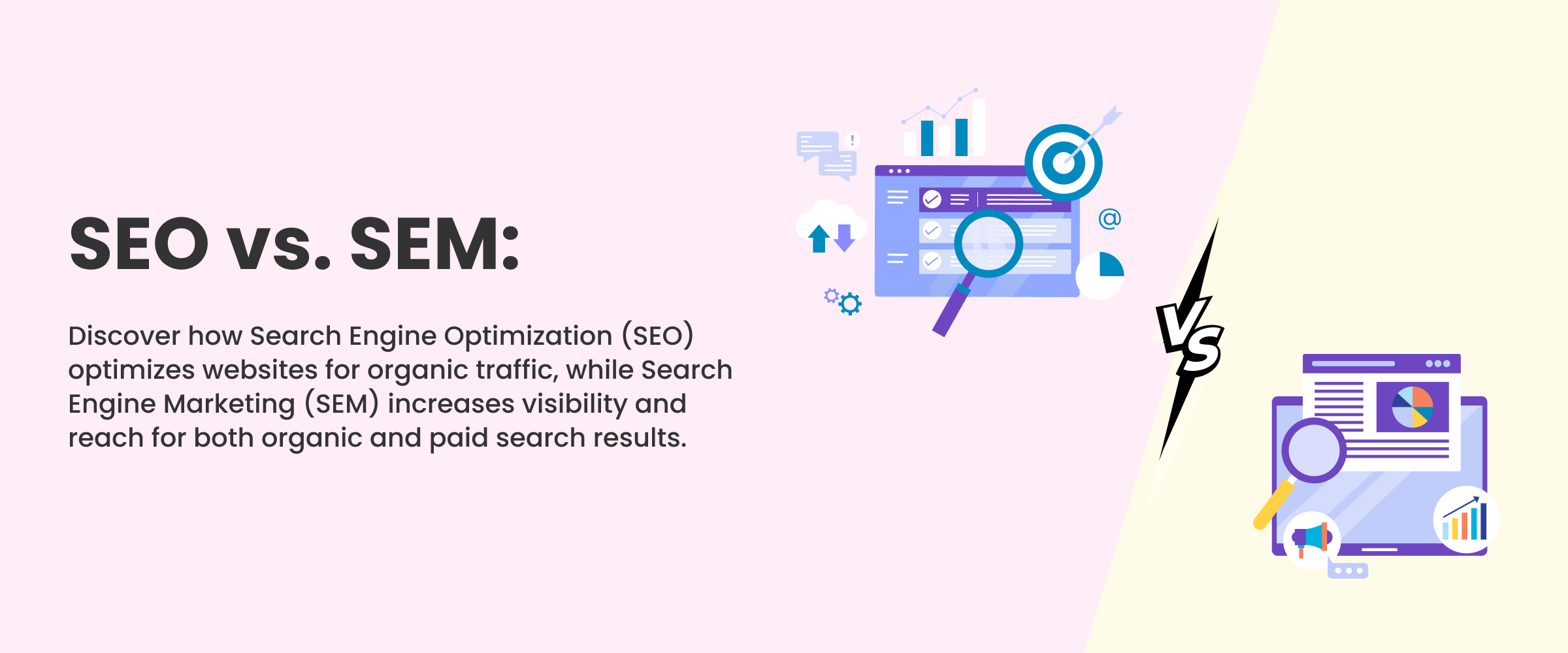SEO vs SEM: Which is better?
A study analyzed a variety of business websites and found that about 53% of their overall traffic comes from organic search, whereas the rest comes from direct traffic, referral links, paid advertising, and social media. To have clarity about different methods of generating traffic, you must understand the distinction between SEO and SEM. In this blog, we will explore key differences between SEO and SEM, their advantages and disadvantages, along with a brief comparison to help you determine which one is suitable for you.
SEO vs SEM: Overview
SEO, or search engine optimization, is a practice where a website is optimized continuously to ensure it ranks in organic, non-paid search engine results pages, or SERPs. The focus is to improve the quality and quantity of the website traffic that is coming from the search engines to the website.
SEM, or search engine marketing, is a digital marketing strategy that, with the help of promotion and advertising, increases the visibility or rank of a website in search engine results pages, or SERPs. It uses both paid and organic ways to reach new customers and increase revenue. When one uses SEM, their content will appear above the non-paid or organic results in the search engine. Taking an online digital marketing course will enhance your knowledge of best SEO and SEM practices, an essential skill for a digital marketer.
Comparative Analysis Between SEO and SEM
SEO and SEM are both marketing channels that are used by businesses to reach their target users on search engines. They have become essential for the growth and visibility of brands and content. Let us discuss the key differences between SEO and SEM and compare them briefly across various parameters.
1. Key Differences
Here are the key differences:
| Parameter | SEO (Search Engine Optimization) | SEM (Search Engine Marketing) |
| Use | It is used to rank a website in organic search results. | It is used to rank a website in paid results. |
| Goal | The goal is to increase the visibility of a website. | The goal is to increase the sales of a business. |
| Features | It includes on-page SEO, off-page SEO, technical SEO, and user interaction signals. | It includes PPC, or pay-per-click, bidding, quality score, ad copy, ad groups, and account management. |
| Speed | It takes time and is slow to show results. | It shows results quickly. |
| Cost | It is expensive in the beginning but requires next to no investment at later stages. | It is cheaper in the short term but expensive in the long term. |
| Competition | Competition is less since organic content is required. | Competition is more since it targets specific areas. |
| Results | Unlimited traffic potential. | Limited traffic potential since it depends on the budget. |
| Target Audience | Search results do not target an audience. | Search results target a section of the audience. |
| Example | Keywords, Backlinks | Google AdSense |


2. Brief Comparison
Here is a brief comparison to better understand what is the difference between SEO and SEM.
i. Marketing
- Search engine optimization is a subset of SEM, also referred to as organic SEM.
- Search engine Marketing is an umbrella term or superset that includes SEO along with other methods to increase the traffic to the website.
ii. Features
- SEO includes on-page SEO, off-page SEO, technical SEO, and user interaction signals. These use keywords, backlinks, and optimizing site architecture among others to optimize the website for search engines.
- SEM includes other than SEO, PPC, or pay-per-click. It has bidding, quality score, ad copy, ad groups, and account management as features. They are used to decide and optimize the spend per click on their website.
iii. Use
- SEO is used to rank a website in organic search results using organic methods.
- Whereas, SEM is used to rank a website in paid results which usually appear above the organic results on a search engine result page.
iv. Goal
- The goal depicts the SEO and SEM differences. SEO aims to increase the visibility of a website so that there are more user interactions with the content.
- SEM stresses more on increasing the sales of a business. For this, the conversion rate, that is, the number of users interacting with the website and the number among them making a purchase, should be high.
v. Result
- SEO has unlimited traffic potential since the target audience is not defined. The results are slow and take time in this case.
- SEM has a limited traffic potential since the target audience is defined. The results are quick here.
vi. Cost
- In SEO, one spends on web page design, illustrations, content optimization, and building strong backlinks. It is expensive in the beginning but at later stages, the cost is reduced by huge margins.
- SEM is expensive in the long term. The amount paid initially might fetch us results in the form of click-throughs but we need to keep investing to maintain these results.
vii. Benefits
- With SEO, the benefits are visible in the long term but they are maintained even when we stop investing.
- With SEM, the benefits are visible in the short term. One does not need to wait for a long period to see sales in their business.
viii. Suitability
- SEO is suitable for small businesses since a website can be optimized with an up-front amount. It can be done with a convenient budget according to the requirements of the business.
- SEM is suitable for big businesses that can and want to invest large amounts in advertising and marketing to fetch faster results.
Enroll in the digital marketing placement guarantee course and learn SEO and SEM with the best trainers in the market.
SEO vs SEM: Advantages
Here is a table that compares the benefits of both SEO and SEO.
| Advantages of SEO | Advantages of SEM |
| Increases the visibility of a page through organic methods. | Increases the visibility of a page through both organic and paid methods. |
| Keywords help the page in appearing in the search engine results pages of the relevant searches. | Bidding, a component of SEM helps in ensuring that our page ranks in the search engine results pages of the targeted audience. |
| High-quality backlinks strengthen the trust and authority of our website. | A compelling ad copy attracts visitors to the web page and increases the click-through rate. |
| Technical SEO helps in ensuring the search engine crawler can crawl through the page and index it properly. It helps with the accessibility of the web page. | The quality score of the web page helps one to get a discount on the cost-per-click for their ad copy. |
| The user interaction signals help in knowing the bounce rate of a web page so that we can optimize it accordingly. | With Ad groups and account management, we can customize and view the performance of our ads and further optimize our ad spend. |
SEO vs SEM: Disadvantages
Here is a table that compares the disadvantages of both SEO and SEO.
| Disadvantages of SEO | Disadvantages of SEM |
| The process is slow and cannot fetch desired results even after a long time. | Results are quick but cannot be up to the desired levels or drop by high margins. |
| Acquiring high-quality backlinks can cost one a lot. | Designing the ad copy and further bidding can cost a lot. |
| Popular keywords can bring in the traffic but if the visitors do not find the information relevant, the bounce rate can increase. | The click-through rate might be high but not necessarily the conversion rate. |
| Not everyone understands the nuances of search engine optimization. | Search engine marketing requires a professional who knows how to target the correct audience with paid advertisements. |
| The competition is high with more and more people employing SEO tools to enhance their content’s visibility. | The competition is in terms of bidding. Someone might bid more than you and your ad will be pushed below them in the SERPs. |
| If you are not ranked higher, your content might see less or no traction at all. | Ad blockers can hamper your reach. |
Which One to Prefer-SEO vs. SEM?
When both SEO and SEM in digital marketing are appealing, one might get confused about which one to prefer over the other. Here are some points to help you make a better decision.
- One can prefer SEO when they have a limited budget, are patient, are familiar with link-building strategies, and know how to use informational keywords.
- On the other hand, one can prefer to utilize SEM, if they have a consistent budget for the ads, can manage AdWords accounts, and can launch and test landing pages.
- Additionally, if one has a large workforce and a good budget, they can use both SEO and SEM to not just increase the viability of their website on the search engine results page but also get higher conversion in the form of purchases.
Conclusion
Attracting traffic to a website on a search engine can be difficult if the techniques are not employed correctly. Knowing about SEO and SEM helps with this. They encompass within themselves several other techniques. The brief comparison of SEO vs. SEM will help you in making the choice regarding your next digital marketing move for your business.







